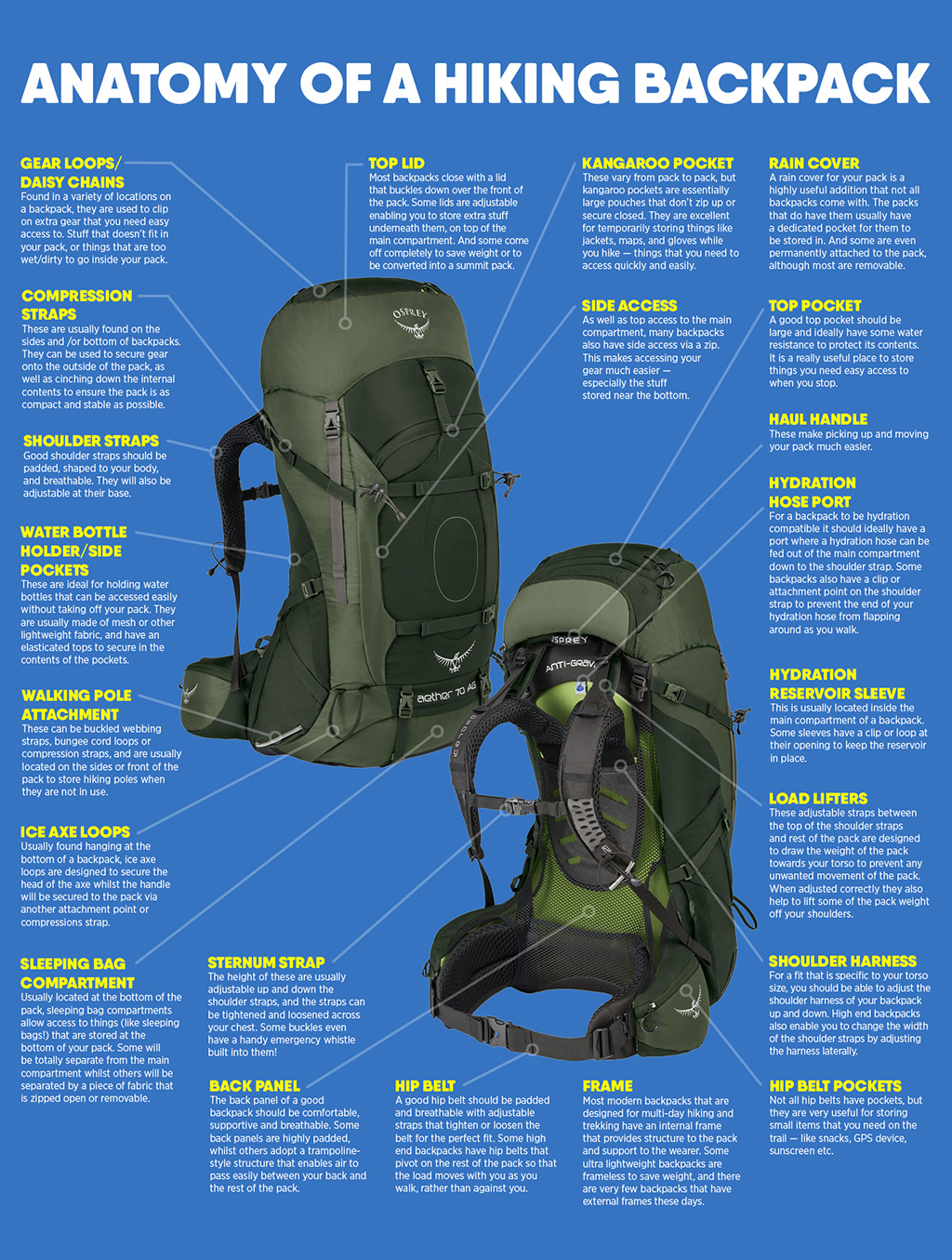 GEAR LOOPS/DAISY CHAINS
GEAR LOOPS/DAISY CHAINSFound in a variety of locations on a backpack, they are used to clip on extra gear that you need easy access to. Stuff that doesn't fit in your pack, or things that are too wet/dirty to go inside your pack.
COMPRESSION STRAPS
These are usually found on the sides and /or bottom of backpacks. They can be used to secure gear onto the outside of the pack, as well as cinching down the internal contents to ensure the pack is as compact and stable as possible.
SHOULDER STRAPS
Good shoulder straps should be padded, shaped to your body, and breathable. They will also be adjustable at their base.
WATER BOTTLE HOLDER/SIDE POCKETS
These are ideal for holding water bottles that can be accessed easily without taking off your pack. They are usually made of mesh or other lightweight fabric, and have an elasticated tops to secure in the contents of the pockets.
WALKING POLE ATTACHMENT
These can be bucked webbing straps, bungee cord loops or compression straps, and are usually located on the sides or front of the pack to store hiking poles when they are not in use.
ICE AXE LOOPS
Usually found hanging at the bottom of a backpack, ice axe loops are designed to secure the head of the axe whilst the handle will be secured to the pack via another attachment point or compressions strap.
SLEEPING BAG COMPARTMENT
Usually located at the bottom of the pack, sleeping bag compartments allow access to things (like sleeping bags!) that are stored at the bottom of your pack. Some will be totally separate from the main compartment whilst others will be separated by a piece of fabric that is zipped open or removable.
STERNUM STRAP
The height of these are usually adjustable up and down the shoulder straps, and the straps can be tightened and loosened across your chest. Some buckles even have a handy emergency whistle built into them!
BACK PANEL
The back panel of a good backpack should be comfortable, whilst others adopt a trampoline-style structure that enables air to pass easily between your back and the rest of the pack.
TOP LID
Most backpacks close with a lid that buckles down over the front of the pack. Some lids are adjustable enabling you to store extra stuff underneath them, on top of the main compartment. And some come off completely to save weight or to be converted into a summit pack.
HIP BELT
A good hip belt should be padded and breathable with adjustable straps that tighten or loosen the belt for the perfect fit. Some high end backpacks have hip belts that pivot on the rest of the pack so that the load moves with you as you walk, rather than against you.
KANGAROO POCKET
These vary from pack to pack, but kangaroo pockets are essentially large pouches that don't zip up or secure closed. They are excellent for temporarily storing things like jackets, maps, and gloves while you hike - things that you need to access quickly and easily.
SIDE ACCESS
As well as top access to the main compartment, many backpacks also have side access via a zip. This makes accessing your gear much easier especially the stuff stored near the bottom.
FRAME
Most modern backpacks that are designed for multi-day hiking and trekking have an internal frame that provides structure to the pack and support to the wearer. Some ultra lightweight backpacks are frameless to save weight, and there are very few backpacks that have external frames these days.
RAIN COVER
A rain cover for your pack is a highly useful addition that not all backpacks come with, The packs that do have them usually have a dedicated pocket for them to be stored in, And some are even permanently attached to the pack, although most are removable.
TOP POCKET
A good top pocket should be large and ideally have some water resistance to protect its contents. It is a really useful place to store things you need easy access to when you stop.
HAUL HANDLE
These make picking up and moving your pack much easier.
HYDRATION HOSEPORT
For a backpack to be hydration compatible it should ideally have a port where a hydration hose can be fed out of the main compartment down to the shoulder strap. Some backpacks also have a clip or attachment point on the shoulder strap to prevent the end of your hydration hose from flapping around as you walk.
HYDRATION RESERVOIR SLEEVE
This is usually located inside the main compartment of a backpack. Some sleeves have a clip or loop at their opening to keep the reservoir in place.
LOAD LIFTERS
These adjustable straps between the top of the shoulder straps and rest of the pack are designed to draw the weight of the pack towards your torso to prevent any unwanted movement of the pack. When adjusted correctly they also help to lift some of the pack weight off your shoulders.
SHOULDER HARNESS
For a fit that is specific to your torso size, you should be able to adjust the shoulder harness of your backpack up and down, High end backpacks also enable you to change the width of the shoulder straps by adjusting the harness laterally.
HIP BELT POCKETS
Not all hip belts have pockets, but they are very useful for storing small items that you need on the trail - like snacks, GPS device, sunscreen etc.
Understand the Parts of a Backpack for Trekking and Backpacking
No comments:
Post a Comment